Analysis of Market Structure: UK Energy and Gas Providers
VerifiedAdded on 2022/01/25
|16
|3872
|238
Essay
AI Summary
This essay provides an in-depth analysis of the market structure of energy and gas providers in the UK. It begins by outlining the key steps in supplying energy to homes, from generation to supply, and highlights the liberalized and competitive nature of the UK energy market. The role of the Office of Gas and Electricity Markets (Ofgem) in regulating the market is explained, emphasizing its function in protecting consumer interests. The essay then delves into the structure of the market, identifying the oligopolistic nature of the electricity generation market and the dominance of the 'Big Six' energy suppliers. It discusses the factors influencing energy prices, including wholesale costs, supplier pricing tactics, and regional variations, such as the 'postcode lottery.' The essay also examines the impact of market dynamics, including customer switching rates, consumer confidence, and regulatory constraints. Furthermore, it explores the role of Distribution Network Operators (DNOs) and Gas Distribution Networks (GDNs) in setting prices, the influence of supply and demand, and the role of Ofgem in ensuring fair treatment and promoting competition in the energy market. The essay concludes by discussing Ofgem's responsibilities, including working with the government, industry, and consumer groups to achieve a net-zero economy while ensuring fair treatment for all consumers.
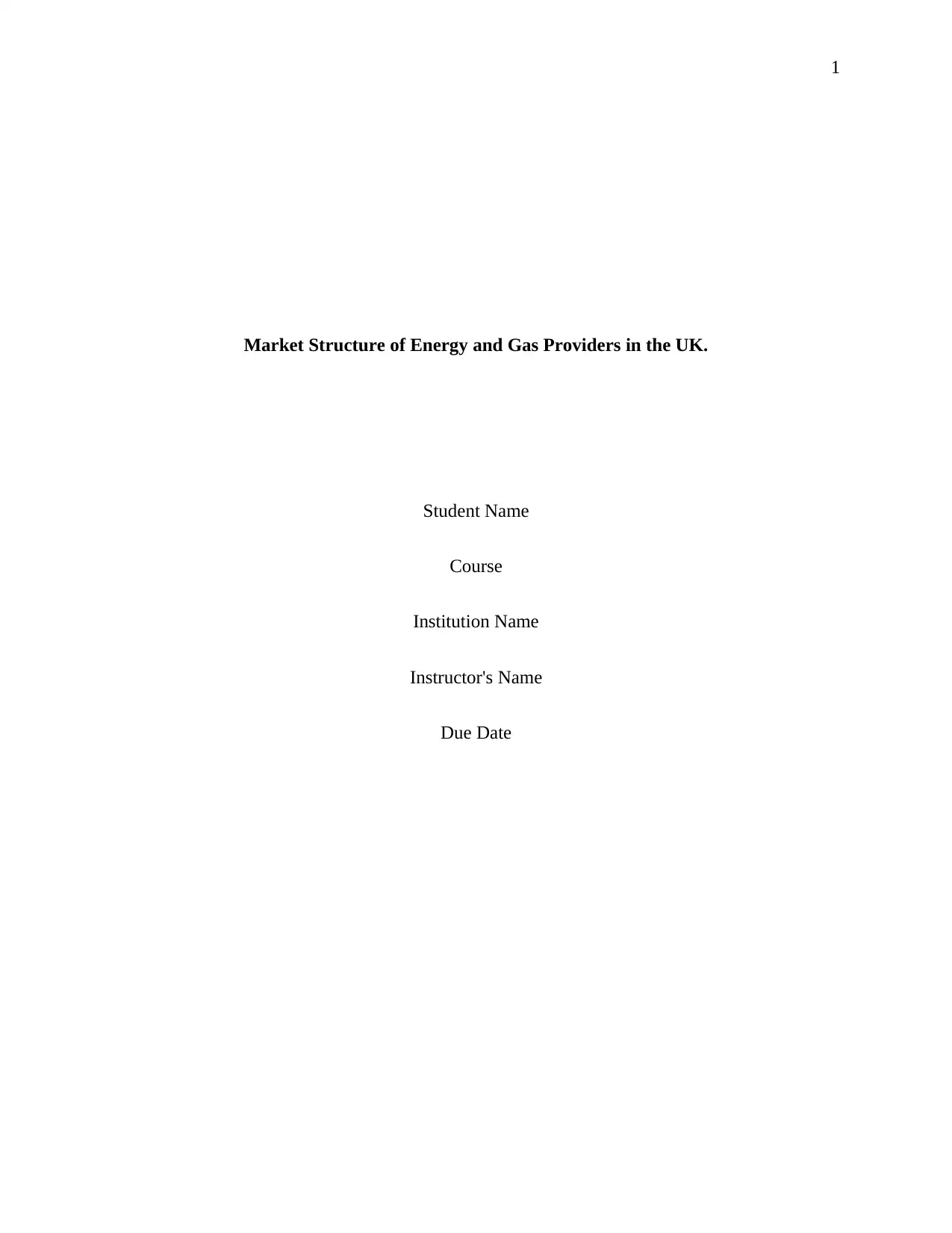
1
Market Structure of Energy and Gas Providers in the UK.
Student Name
Course
Institution Name
Instructor's Name
Due Date
Market Structure of Energy and Gas Providers in the UK.
Student Name
Course
Institution Name
Instructor's Name
Due Date
Paraphrase This Document
Need a fresh take? Get an instant paraphrase of this document with our AI Paraphraser
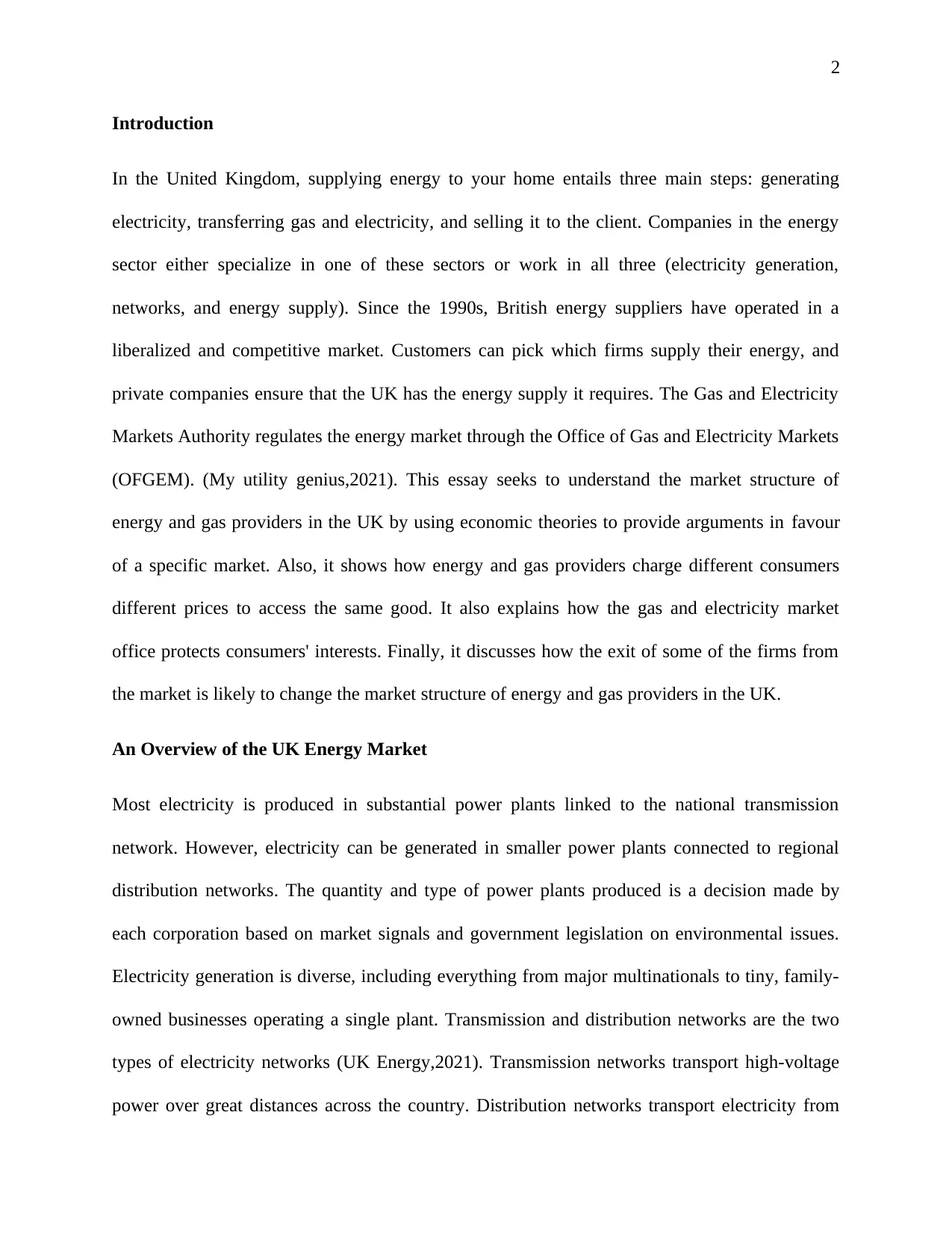
2
Introduction
In the United Kingdom, supplying energy to your home entails three main steps: generating
electricity, transferring gas and electricity, and selling it to the client. Companies in the energy
sector either specialize in one of these sectors or work in all three (electricity generation,
networks, and energy supply). Since the 1990s, British energy suppliers have operated in a
liberalized and competitive market. Customers can pick which firms supply their energy, and
private companies ensure that the UK has the energy supply it requires. The Gas and Electricity
Markets Authority regulates the energy market through the Office of Gas and Electricity Markets
(OFGEM). (My utility genius,2021). This essay seeks to understand the market structure of
energy and gas providers in the UK by using economic theories to provide arguments in favour
of a specific market. Also, it shows how energy and gas providers charge different consumers
different prices to access the same good. It also explains how the gas and electricity market
office protects consumers' interests. Finally, it discusses how the exit of some of the firms from
the market is likely to change the market structure of energy and gas providers in the UK.
An Overview of the UK Energy Market
Most electricity is produced in substantial power plants linked to the national transmission
network. However, electricity can be generated in smaller power plants connected to regional
distribution networks. The quantity and type of power plants produced is a decision made by
each corporation based on market signals and government legislation on environmental issues.
Electricity generation is diverse, including everything from major multinationals to tiny, family-
owned businesses operating a single plant. Transmission and distribution networks are the two
types of electricity networks (UK Energy,2021). Transmission networks transport high-voltage
power over great distances across the country. Distribution networks transport electricity from
Introduction
In the United Kingdom, supplying energy to your home entails three main steps: generating
electricity, transferring gas and electricity, and selling it to the client. Companies in the energy
sector either specialize in one of these sectors or work in all three (electricity generation,
networks, and energy supply). Since the 1990s, British energy suppliers have operated in a
liberalized and competitive market. Customers can pick which firms supply their energy, and
private companies ensure that the UK has the energy supply it requires. The Gas and Electricity
Markets Authority regulates the energy market through the Office of Gas and Electricity Markets
(OFGEM). (My utility genius,2021). This essay seeks to understand the market structure of
energy and gas providers in the UK by using economic theories to provide arguments in favour
of a specific market. Also, it shows how energy and gas providers charge different consumers
different prices to access the same good. It also explains how the gas and electricity market
office protects consumers' interests. Finally, it discusses how the exit of some of the firms from
the market is likely to change the market structure of energy and gas providers in the UK.
An Overview of the UK Energy Market
Most electricity is produced in substantial power plants linked to the national transmission
network. However, electricity can be generated in smaller power plants connected to regional
distribution networks. The quantity and type of power plants produced is a decision made by
each corporation based on market signals and government legislation on environmental issues.
Electricity generation is diverse, including everything from major multinationals to tiny, family-
owned businesses operating a single plant. Transmission and distribution networks are the two
types of electricity networks (UK Energy,2021). Transmission networks transport high-voltage
power over great distances across the country. Distribution networks transport electricity from
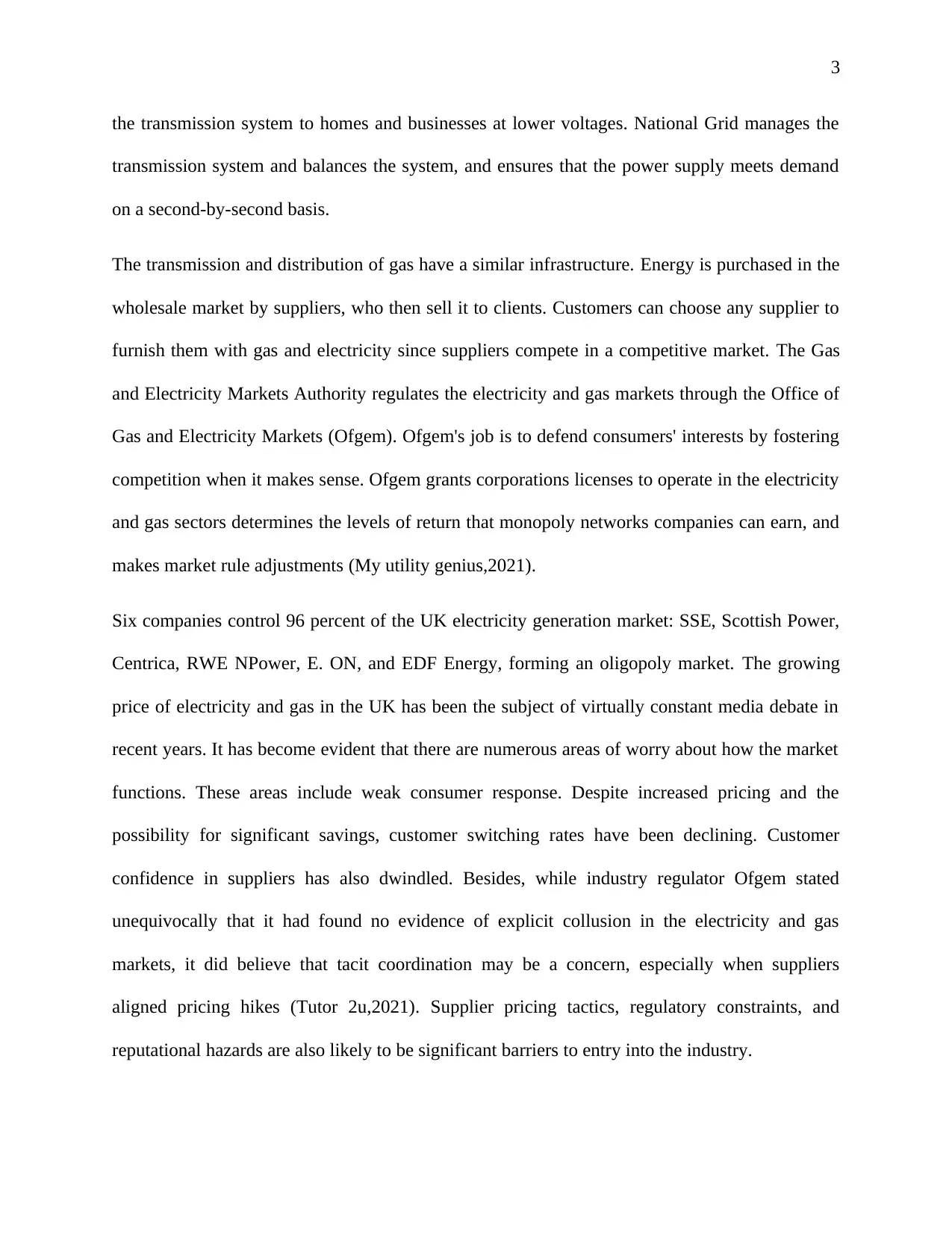
3
the transmission system to homes and businesses at lower voltages. National Grid manages the
transmission system and balances the system, and ensures that the power supply meets demand
on a second-by-second basis.
The transmission and distribution of gas have a similar infrastructure. Energy is purchased in the
wholesale market by suppliers, who then sell it to clients. Customers can choose any supplier to
furnish them with gas and electricity since suppliers compete in a competitive market. The Gas
and Electricity Markets Authority regulates the electricity and gas markets through the Office of
Gas and Electricity Markets (Ofgem). Ofgem's job is to defend consumers' interests by fostering
competition when it makes sense. Ofgem grants corporations licenses to operate in the electricity
and gas sectors determines the levels of return that monopoly networks companies can earn, and
makes market rule adjustments (My utility genius,2021).
Six companies control 96 percent of the UK electricity generation market: SSE, Scottish Power,
Centrica, RWE NPower, E. ON, and EDF Energy, forming an oligopoly market. The growing
price of electricity and gas in the UK has been the subject of virtually constant media debate in
recent years. It has become evident that there are numerous areas of worry about how the market
functions. These areas include weak consumer response. Despite increased pricing and the
possibility for significant savings, customer switching rates have been declining. Customer
confidence in suppliers has also dwindled. Besides, while industry regulator Ofgem stated
unequivocally that it had found no evidence of explicit collusion in the electricity and gas
markets, it did believe that tacit coordination may be a concern, especially when suppliers
aligned pricing hikes (Tutor 2u,2021). Supplier pricing tactics, regulatory constraints, and
reputational hazards are also likely to be significant barriers to entry into the industry.
the transmission system to homes and businesses at lower voltages. National Grid manages the
transmission system and balances the system, and ensures that the power supply meets demand
on a second-by-second basis.
The transmission and distribution of gas have a similar infrastructure. Energy is purchased in the
wholesale market by suppliers, who then sell it to clients. Customers can choose any supplier to
furnish them with gas and electricity since suppliers compete in a competitive market. The Gas
and Electricity Markets Authority regulates the electricity and gas markets through the Office of
Gas and Electricity Markets (Ofgem). Ofgem's job is to defend consumers' interests by fostering
competition when it makes sense. Ofgem grants corporations licenses to operate in the electricity
and gas sectors determines the levels of return that monopoly networks companies can earn, and
makes market rule adjustments (My utility genius,2021).
Six companies control 96 percent of the UK electricity generation market: SSE, Scottish Power,
Centrica, RWE NPower, E. ON, and EDF Energy, forming an oligopoly market. The growing
price of electricity and gas in the UK has been the subject of virtually constant media debate in
recent years. It has become evident that there are numerous areas of worry about how the market
functions. These areas include weak consumer response. Despite increased pricing and the
possibility for significant savings, customer switching rates have been declining. Customer
confidence in suppliers has also dwindled. Besides, while industry regulator Ofgem stated
unequivocally that it had found no evidence of explicit collusion in the electricity and gas
markets, it did believe that tacit coordination may be a concern, especially when suppliers
aligned pricing hikes (Tutor 2u,2021). Supplier pricing tactics, regulatory constraints, and
reputational hazards are also likely to be significant barriers to entry into the industry.
⊘ This is a preview!⊘
Do you want full access?
Subscribe today to unlock all pages.

Trusted by 1+ million students worldwide
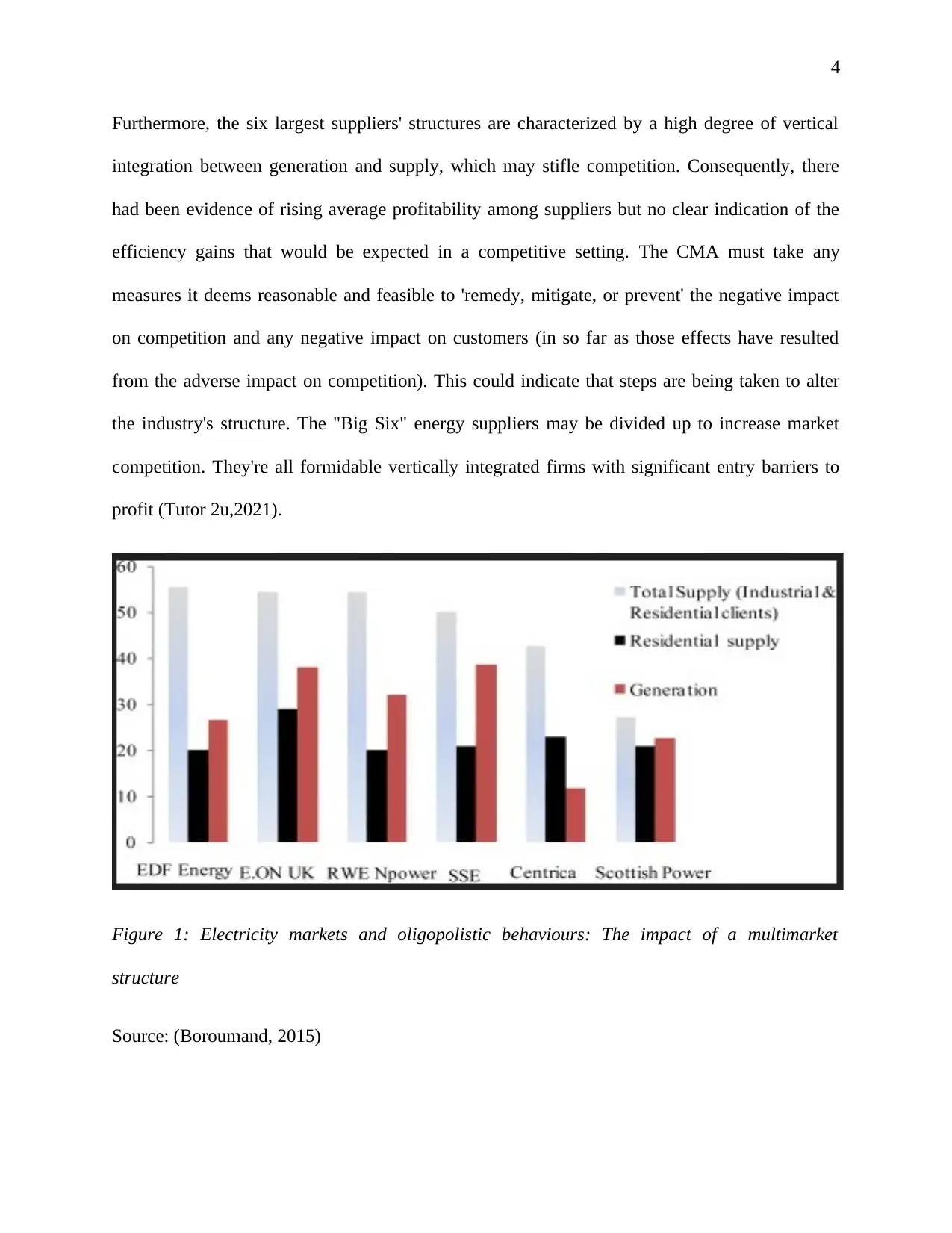
4
Furthermore, the six largest suppliers' structures are characterized by a high degree of vertical
integration between generation and supply, which may stifle competition. Consequently, there
had been evidence of rising average profitability among suppliers but no clear indication of the
efficiency gains that would be expected in a competitive setting. The CMA must take any
measures it deems reasonable and feasible to 'remedy, mitigate, or prevent' the negative impact
on competition and any negative impact on customers (in so far as those effects have resulted
from the adverse impact on competition). This could indicate that steps are being taken to alter
the industry's structure. The "Big Six" energy suppliers may be divided up to increase market
competition. They're all formidable vertically integrated firms with significant entry barriers to
profit (Tutor 2u,2021).
Figure 1: Electricity markets and oligopolistic behaviours: The impact of a multimarket
structure
Source: (Boroumand, 2015)
Furthermore, the six largest suppliers' structures are characterized by a high degree of vertical
integration between generation and supply, which may stifle competition. Consequently, there
had been evidence of rising average profitability among suppliers but no clear indication of the
efficiency gains that would be expected in a competitive setting. The CMA must take any
measures it deems reasonable and feasible to 'remedy, mitigate, or prevent' the negative impact
on competition and any negative impact on customers (in so far as those effects have resulted
from the adverse impact on competition). This could indicate that steps are being taken to alter
the industry's structure. The "Big Six" energy suppliers may be divided up to increase market
competition. They're all formidable vertically integrated firms with significant entry barriers to
profit (Tutor 2u,2021).
Figure 1: Electricity markets and oligopolistic behaviours: The impact of a multimarket
structure
Source: (Boroumand, 2015)
Paraphrase This Document
Need a fresh take? Get an instant paraphrase of this document with our AI Paraphraser
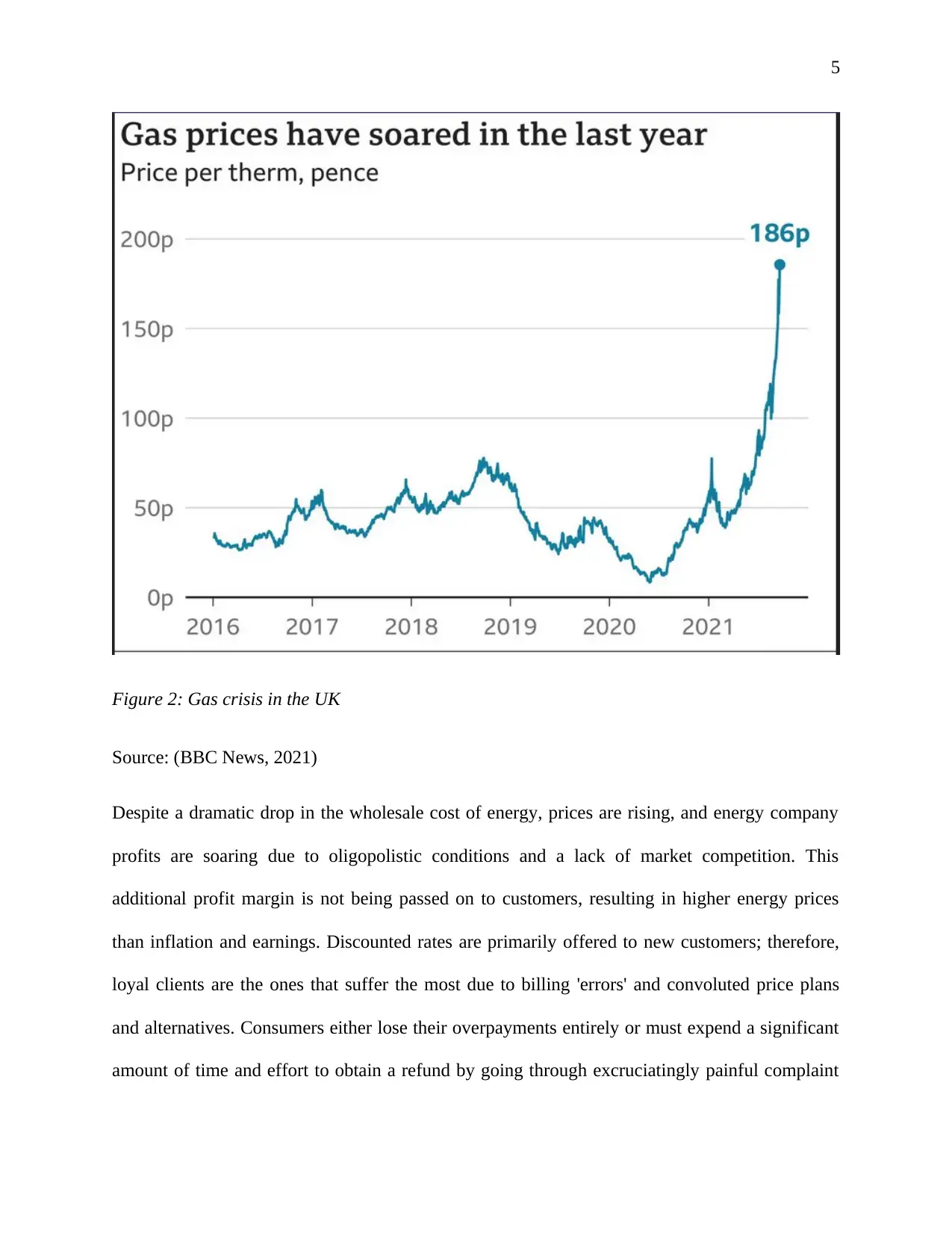
5
Figure 2: Gas crisis in the UK
Source: (BBC News, 2021)
Despite a dramatic drop in the wholesale cost of energy, prices are rising, and energy company
profits are soaring due to oligopolistic conditions and a lack of market competition. This
additional profit margin is not being passed on to customers, resulting in higher energy prices
than inflation and earnings. Discounted rates are primarily offered to new customers; therefore,
loyal clients are the ones that suffer the most due to billing 'errors' and convoluted price plans
and alternatives. Consumers either lose their overpayments entirely or must expend a significant
amount of time and effort to obtain a refund by going through excruciatingly painful complaint
Figure 2: Gas crisis in the UK
Source: (BBC News, 2021)
Despite a dramatic drop in the wholesale cost of energy, prices are rising, and energy company
profits are soaring due to oligopolistic conditions and a lack of market competition. This
additional profit margin is not being passed on to customers, resulting in higher energy prices
than inflation and earnings. Discounted rates are primarily offered to new customers; therefore,
loyal clients are the ones that suffer the most due to billing 'errors' and convoluted price plans
and alternatives. Consumers either lose their overpayments entirely or must expend a significant
amount of time and effort to obtain a refund by going through excruciatingly painful complaint
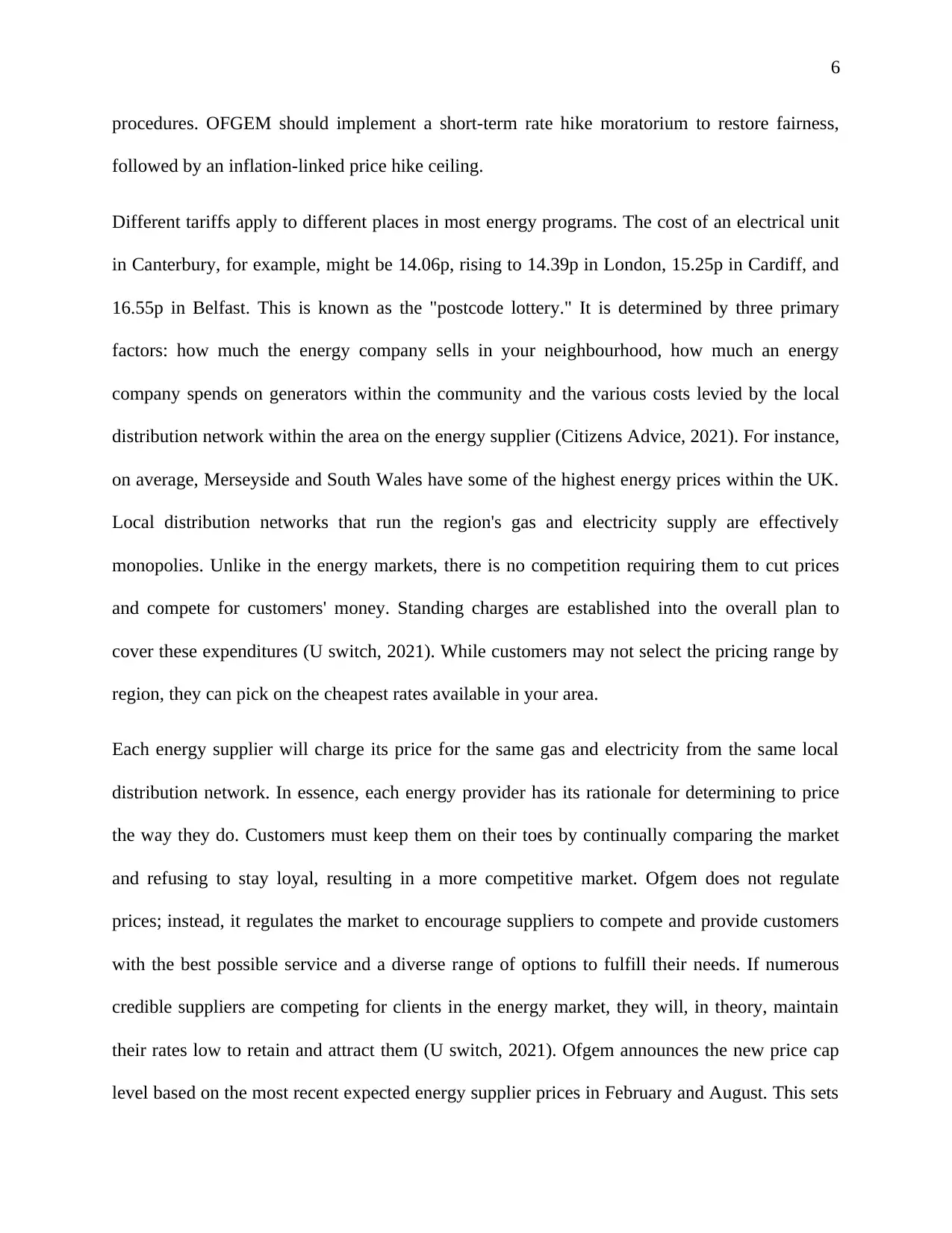
6
procedures. OFGEM should implement a short-term rate hike moratorium to restore fairness,
followed by an inflation-linked price hike ceiling.
Different tariffs apply to different places in most energy programs. The cost of an electrical unit
in Canterbury, for example, might be 14.06p, rising to 14.39p in London, 15.25p in Cardiff, and
16.55p in Belfast. This is known as the "postcode lottery." It is determined by three primary
factors: how much the energy company sells in your neighbourhood, how much an energy
company spends on generators within the community and the various costs levied by the local
distribution network within the area on the energy supplier (Citizens Advice, 2021). For instance,
on average, Merseyside and South Wales have some of the highest energy prices within the UK.
Local distribution networks that run the region's gas and electricity supply are effectively
monopolies. Unlike in the energy markets, there is no competition requiring them to cut prices
and compete for customers' money. Standing charges are established into the overall plan to
cover these expenditures (U switch, 2021). While customers may not select the pricing range by
region, they can pick on the cheapest rates available in your area.
Each energy supplier will charge its price for the same gas and electricity from the same local
distribution network. In essence, each energy provider has its rationale for determining to price
the way they do. Customers must keep them on their toes by continually comparing the market
and refusing to stay loyal, resulting in a more competitive market. Ofgem does not regulate
prices; instead, it regulates the market to encourage suppliers to compete and provide customers
with the best possible service and a diverse range of options to fulfill their needs. If numerous
credible suppliers are competing for clients in the energy market, they will, in theory, maintain
their rates low to retain and attract them (U switch, 2021). Ofgem announces the new price cap
level based on the most recent expected energy supplier prices in February and August. This sets
procedures. OFGEM should implement a short-term rate hike moratorium to restore fairness,
followed by an inflation-linked price hike ceiling.
Different tariffs apply to different places in most energy programs. The cost of an electrical unit
in Canterbury, for example, might be 14.06p, rising to 14.39p in London, 15.25p in Cardiff, and
16.55p in Belfast. This is known as the "postcode lottery." It is determined by three primary
factors: how much the energy company sells in your neighbourhood, how much an energy
company spends on generators within the community and the various costs levied by the local
distribution network within the area on the energy supplier (Citizens Advice, 2021). For instance,
on average, Merseyside and South Wales have some of the highest energy prices within the UK.
Local distribution networks that run the region's gas and electricity supply are effectively
monopolies. Unlike in the energy markets, there is no competition requiring them to cut prices
and compete for customers' money. Standing charges are established into the overall plan to
cover these expenditures (U switch, 2021). While customers may not select the pricing range by
region, they can pick on the cheapest rates available in your area.
Each energy supplier will charge its price for the same gas and electricity from the same local
distribution network. In essence, each energy provider has its rationale for determining to price
the way they do. Customers must keep them on their toes by continually comparing the market
and refusing to stay loyal, resulting in a more competitive market. Ofgem does not regulate
prices; instead, it regulates the market to encourage suppliers to compete and provide customers
with the best possible service and a diverse range of options to fulfill their needs. If numerous
credible suppliers are competing for clients in the energy market, they will, in theory, maintain
their rates low to retain and attract them (U switch, 2021). Ofgem announces the new price cap
level based on the most recent expected energy supplier prices in February and August. This sets
⊘ This is a preview!⊘
Do you want full access?
Subscribe today to unlock all pages.

Trusted by 1+ million students worldwide
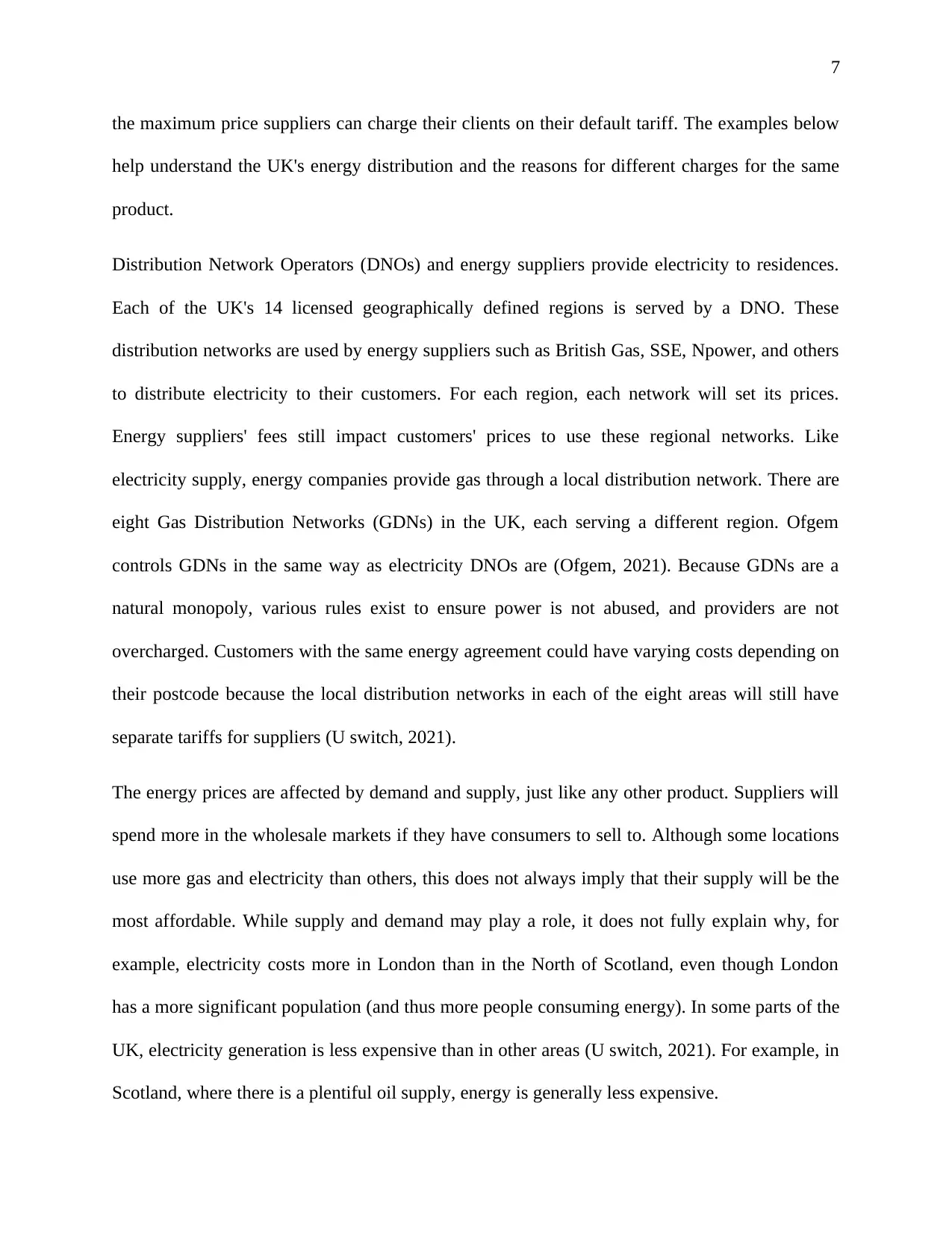
7
the maximum price suppliers can charge their clients on their default tariff. The examples below
help understand the UK's energy distribution and the reasons for different charges for the same
product.
Distribution Network Operators (DNOs) and energy suppliers provide electricity to residences.
Each of the UK's 14 licensed geographically defined regions is served by a DNO. These
distribution networks are used by energy suppliers such as British Gas, SSE, Npower, and others
to distribute electricity to their customers. For each region, each network will set its prices.
Energy suppliers' fees still impact customers' prices to use these regional networks. Like
electricity supply, energy companies provide gas through a local distribution network. There are
eight Gas Distribution Networks (GDNs) in the UK, each serving a different region. Ofgem
controls GDNs in the same way as electricity DNOs are (Ofgem, 2021). Because GDNs are a
natural monopoly, various rules exist to ensure power is not abused, and providers are not
overcharged. Customers with the same energy agreement could have varying costs depending on
their postcode because the local distribution networks in each of the eight areas will still have
separate tariffs for suppliers (U switch, 2021).
The energy prices are affected by demand and supply, just like any other product. Suppliers will
spend more in the wholesale markets if they have consumers to sell to. Although some locations
use more gas and electricity than others, this does not always imply that their supply will be the
most affordable. While supply and demand may play a role, it does not fully explain why, for
example, electricity costs more in London than in the North of Scotland, even though London
has a more significant population (and thus more people consuming energy). In some parts of the
UK, electricity generation is less expensive than in other areas (U switch, 2021). For example, in
Scotland, where there is a plentiful oil supply, energy is generally less expensive.
the maximum price suppliers can charge their clients on their default tariff. The examples below
help understand the UK's energy distribution and the reasons for different charges for the same
product.
Distribution Network Operators (DNOs) and energy suppliers provide electricity to residences.
Each of the UK's 14 licensed geographically defined regions is served by a DNO. These
distribution networks are used by energy suppliers such as British Gas, SSE, Npower, and others
to distribute electricity to their customers. For each region, each network will set its prices.
Energy suppliers' fees still impact customers' prices to use these regional networks. Like
electricity supply, energy companies provide gas through a local distribution network. There are
eight Gas Distribution Networks (GDNs) in the UK, each serving a different region. Ofgem
controls GDNs in the same way as electricity DNOs are (Ofgem, 2021). Because GDNs are a
natural monopoly, various rules exist to ensure power is not abused, and providers are not
overcharged. Customers with the same energy agreement could have varying costs depending on
their postcode because the local distribution networks in each of the eight areas will still have
separate tariffs for suppliers (U switch, 2021).
The energy prices are affected by demand and supply, just like any other product. Suppliers will
spend more in the wholesale markets if they have consumers to sell to. Although some locations
use more gas and electricity than others, this does not always imply that their supply will be the
most affordable. While supply and demand may play a role, it does not fully explain why, for
example, electricity costs more in London than in the North of Scotland, even though London
has a more significant population (and thus more people consuming energy). In some parts of the
UK, electricity generation is less expensive than in other areas (U switch, 2021). For example, in
Scotland, where there is a plentiful oil supply, energy is generally less expensive.
Paraphrase This Document
Need a fresh take? Get an instant paraphrase of this document with our AI Paraphraser
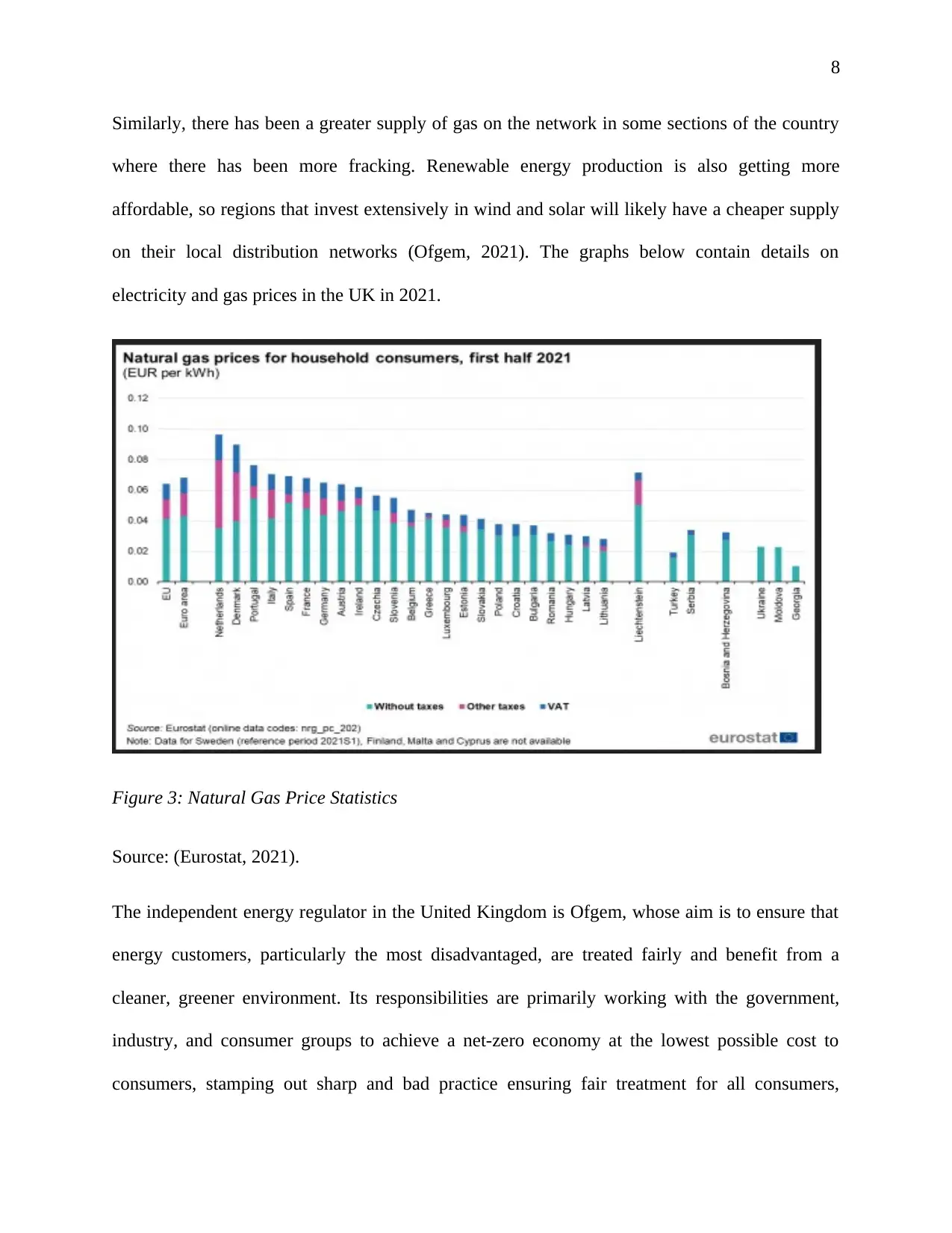
8
Similarly, there has been a greater supply of gas on the network in some sections of the country
where there has been more fracking. Renewable energy production is also getting more
affordable, so regions that invest extensively in wind and solar will likely have a cheaper supply
on their local distribution networks (Ofgem, 2021). The graphs below contain details on
electricity and gas prices in the UK in 2021.
Figure 3: Natural Gas Price Statistics
Source: (Eurostat, 2021).
The independent energy regulator in the United Kingdom is Ofgem, whose aim is to ensure that
energy customers, particularly the most disadvantaged, are treated fairly and benefit from a
cleaner, greener environment. Its responsibilities are primarily working with the government,
industry, and consumer groups to achieve a net-zero economy at the lowest possible cost to
consumers, stamping out sharp and bad practice ensuring fair treatment for all consumers,
Similarly, there has been a greater supply of gas on the network in some sections of the country
where there has been more fracking. Renewable energy production is also getting more
affordable, so regions that invest extensively in wind and solar will likely have a cheaper supply
on their local distribution networks (Ofgem, 2021). The graphs below contain details on
electricity and gas prices in the UK in 2021.
Figure 3: Natural Gas Price Statistics
Source: (Eurostat, 2021).
The independent energy regulator in the United Kingdom is Ofgem, whose aim is to ensure that
energy customers, particularly the most disadvantaged, are treated fairly and benefit from a
cleaner, greener environment. Its responsibilities are primarily working with the government,
industry, and consumer groups to achieve a net-zero economy at the lowest possible cost to
consumers, stamping out sharp and bad practice ensuring fair treatment for all consumers,
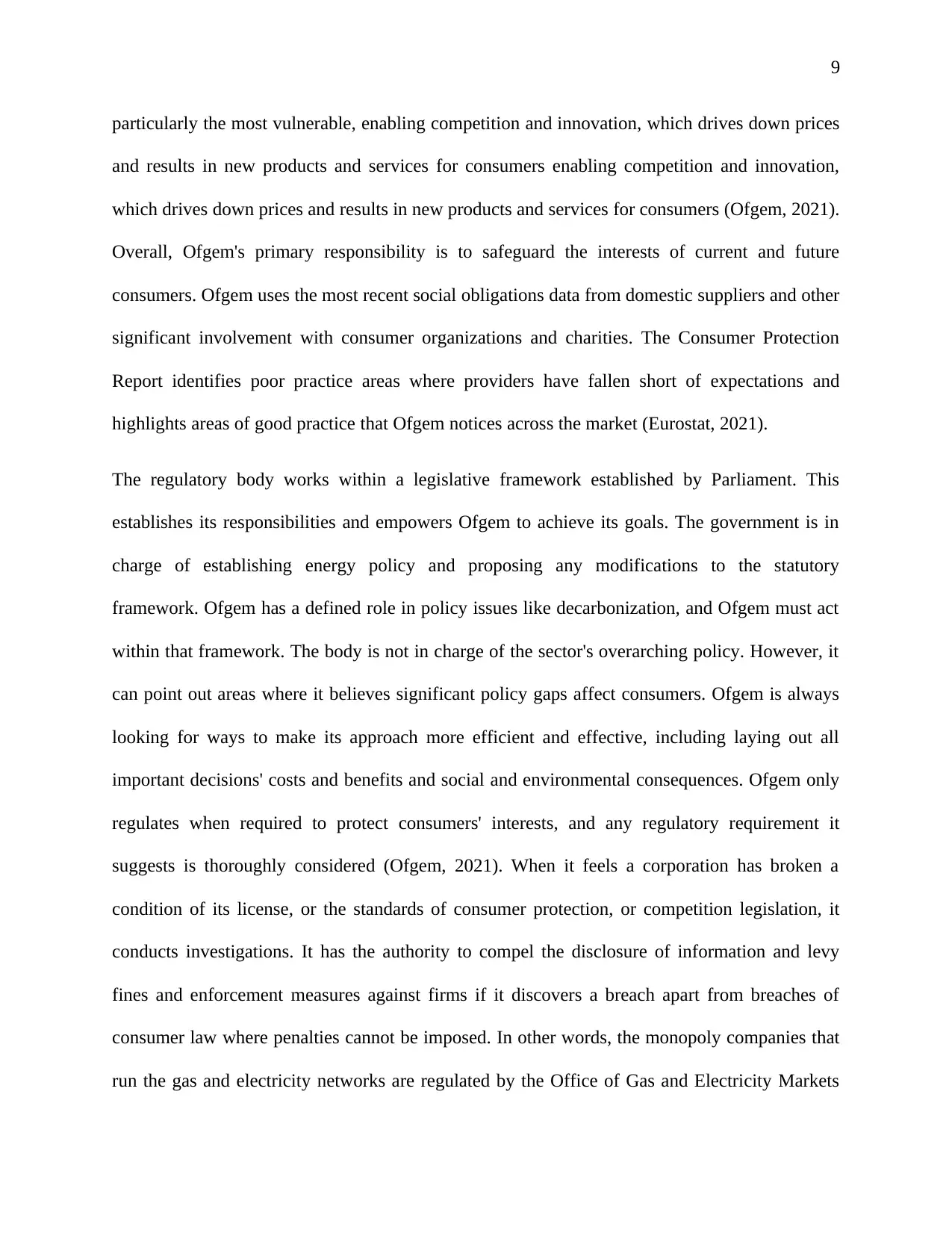
9
particularly the most vulnerable, enabling competition and innovation, which drives down prices
and results in new products and services for consumers enabling competition and innovation,
which drives down prices and results in new products and services for consumers (Ofgem, 2021).
Overall, Ofgem's primary responsibility is to safeguard the interests of current and future
consumers. Ofgem uses the most recent social obligations data from domestic suppliers and other
significant involvement with consumer organizations and charities. The Consumer Protection
Report identifies poor practice areas where providers have fallen short of expectations and
highlights areas of good practice that Ofgem notices across the market (Eurostat, 2021).
The regulatory body works within a legislative framework established by Parliament. This
establishes its responsibilities and empowers Ofgem to achieve its goals. The government is in
charge of establishing energy policy and proposing any modifications to the statutory
framework. Ofgem has a defined role in policy issues like decarbonization, and Ofgem must act
within that framework. The body is not in charge of the sector's overarching policy. However, it
can point out areas where it believes significant policy gaps affect consumers. Ofgem is always
looking for ways to make its approach more efficient and effective, including laying out all
important decisions' costs and benefits and social and environmental consequences. Ofgem only
regulates when required to protect consumers' interests, and any regulatory requirement it
suggests is thoroughly considered (Ofgem, 2021). When it feels a corporation has broken a
condition of its license, or the standards of consumer protection, or competition legislation, it
conducts investigations. It has the authority to compel the disclosure of information and levy
fines and enforcement measures against firms if it discovers a breach apart from breaches of
consumer law where penalties cannot be imposed. In other words, the monopoly companies that
run the gas and electricity networks are regulated by the Office of Gas and Electricity Markets
particularly the most vulnerable, enabling competition and innovation, which drives down prices
and results in new products and services for consumers enabling competition and innovation,
which drives down prices and results in new products and services for consumers (Ofgem, 2021).
Overall, Ofgem's primary responsibility is to safeguard the interests of current and future
consumers. Ofgem uses the most recent social obligations data from domestic suppliers and other
significant involvement with consumer organizations and charities. The Consumer Protection
Report identifies poor practice areas where providers have fallen short of expectations and
highlights areas of good practice that Ofgem notices across the market (Eurostat, 2021).
The regulatory body works within a legislative framework established by Parliament. This
establishes its responsibilities and empowers Ofgem to achieve its goals. The government is in
charge of establishing energy policy and proposing any modifications to the statutory
framework. Ofgem has a defined role in policy issues like decarbonization, and Ofgem must act
within that framework. The body is not in charge of the sector's overarching policy. However, it
can point out areas where it believes significant policy gaps affect consumers. Ofgem is always
looking for ways to make its approach more efficient and effective, including laying out all
important decisions' costs and benefits and social and environmental consequences. Ofgem only
regulates when required to protect consumers' interests, and any regulatory requirement it
suggests is thoroughly considered (Ofgem, 2021). When it feels a corporation has broken a
condition of its license, or the standards of consumer protection, or competition legislation, it
conducts investigations. It has the authority to compel the disclosure of information and levy
fines and enforcement measures against firms if it discovers a breach apart from breaches of
consumer law where penalties cannot be imposed. In other words, the monopoly companies that
run the gas and electricity networks are regulated by the Office of Gas and Electricity Markets
⊘ This is a preview!⊘
Do you want full access?
Subscribe today to unlock all pages.

Trusted by 1+ million students worldwide
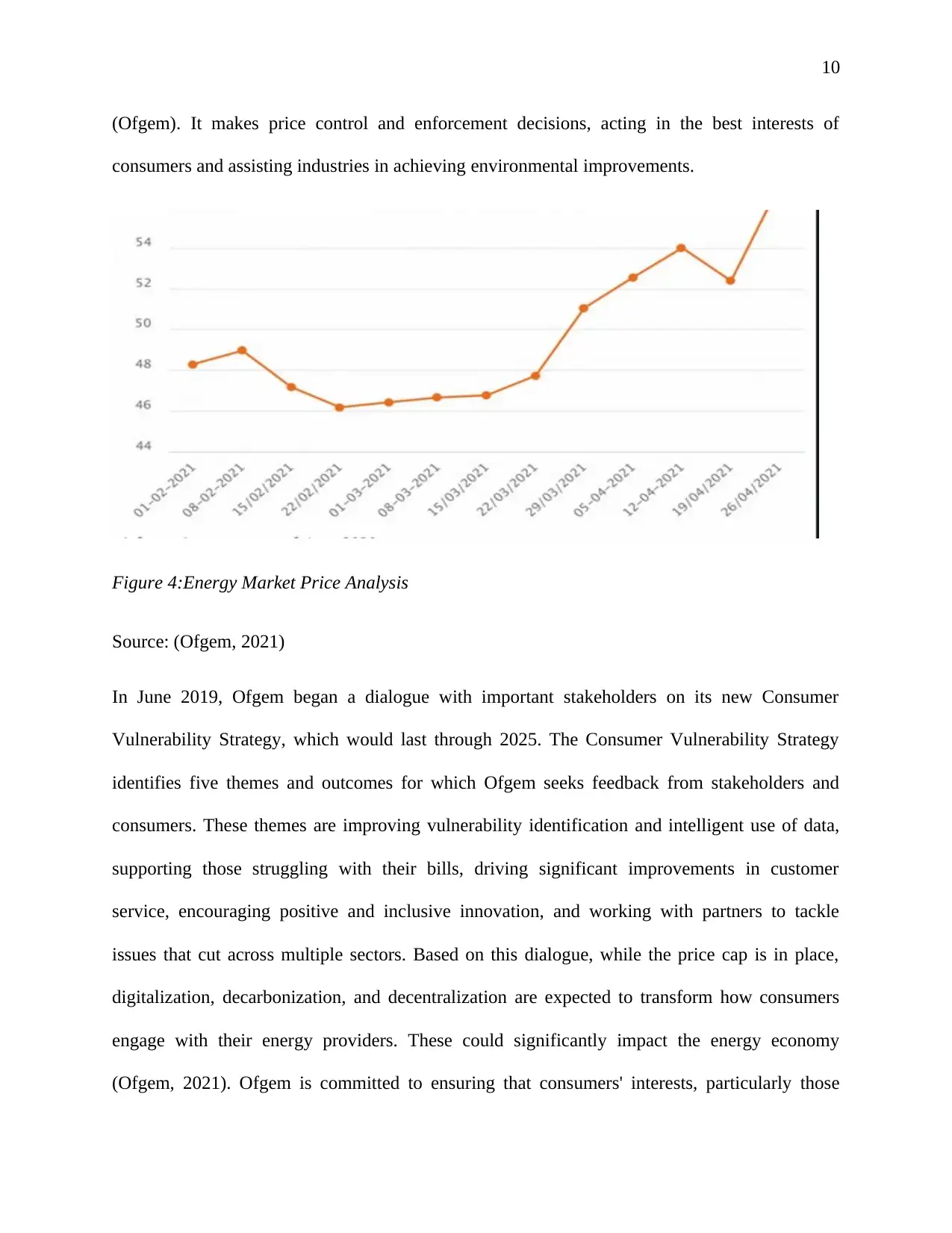
10
(Ofgem). It makes price control and enforcement decisions, acting in the best interests of
consumers and assisting industries in achieving environmental improvements.
Figure 4:Energy Market Price Analysis
Source: (Ofgem, 2021)
In June 2019, Ofgem began a dialogue with important stakeholders on its new Consumer
Vulnerability Strategy, which would last through 2025. The Consumer Vulnerability Strategy
identifies five themes and outcomes for which Ofgem seeks feedback from stakeholders and
consumers. These themes are improving vulnerability identification and intelligent use of data,
supporting those struggling with their bills, driving significant improvements in customer
service, encouraging positive and inclusive innovation, and working with partners to tackle
issues that cut across multiple sectors. Based on this dialogue, while the price cap is in place,
digitalization, decarbonization, and decentralization are expected to transform how consumers
engage with their energy providers. These could significantly impact the energy economy
(Ofgem, 2021). Ofgem is committed to ensuring that consumers' interests, particularly those
(Ofgem). It makes price control and enforcement decisions, acting in the best interests of
consumers and assisting industries in achieving environmental improvements.
Figure 4:Energy Market Price Analysis
Source: (Ofgem, 2021)
In June 2019, Ofgem began a dialogue with important stakeholders on its new Consumer
Vulnerability Strategy, which would last through 2025. The Consumer Vulnerability Strategy
identifies five themes and outcomes for which Ofgem seeks feedback from stakeholders and
consumers. These themes are improving vulnerability identification and intelligent use of data,
supporting those struggling with their bills, driving significant improvements in customer
service, encouraging positive and inclusive innovation, and working with partners to tackle
issues that cut across multiple sectors. Based on this dialogue, while the price cap is in place,
digitalization, decarbonization, and decentralization are expected to transform how consumers
engage with their energy providers. These could significantly impact the energy economy
(Ofgem, 2021). Ofgem is committed to ensuring that consumers' interests, particularly those
Paraphrase This Document
Need a fresh take? Get an instant paraphrase of this document with our AI Paraphraser
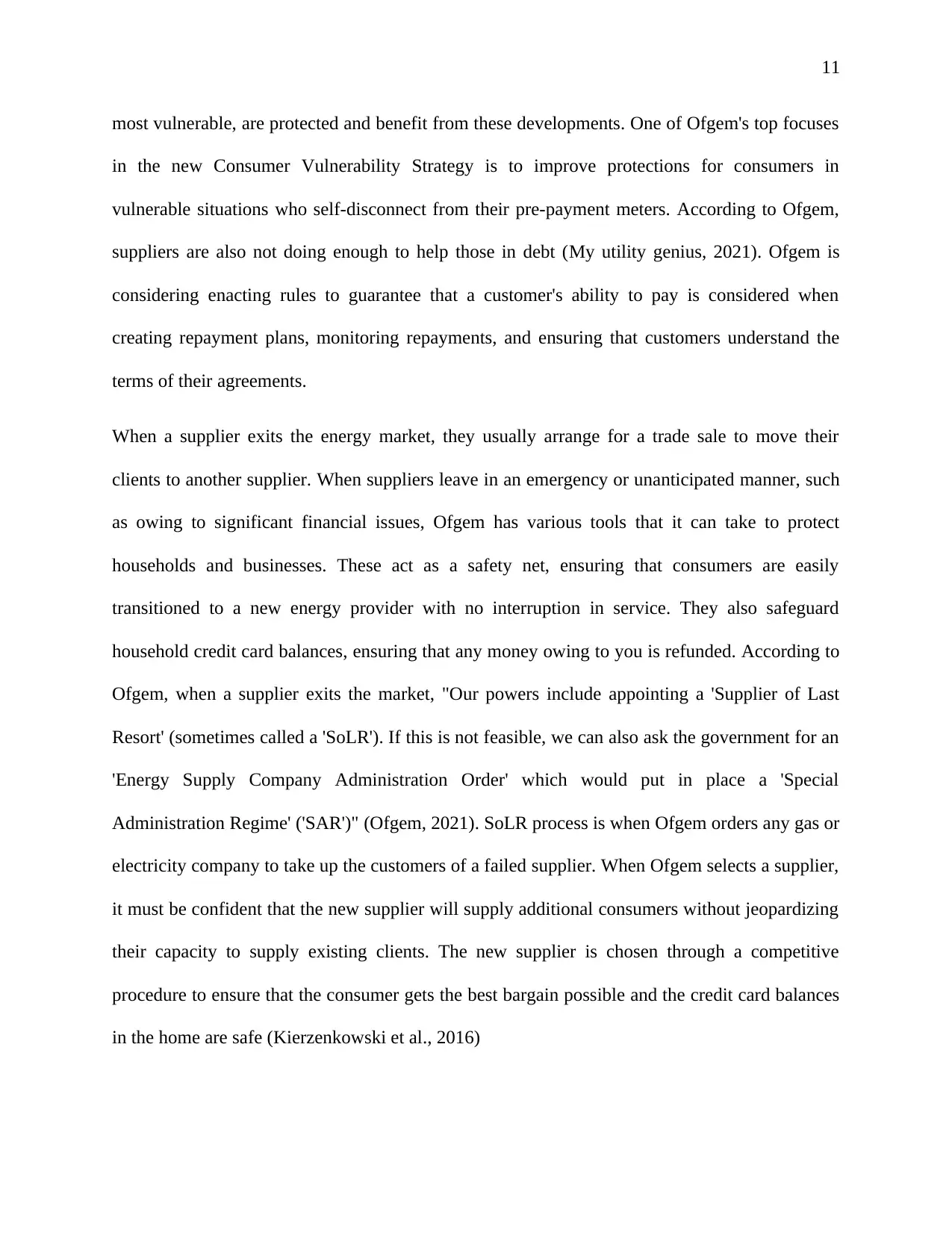
11
most vulnerable, are protected and benefit from these developments. One of Ofgem's top focuses
in the new Consumer Vulnerability Strategy is to improve protections for consumers in
vulnerable situations who self-disconnect from their pre-payment meters. According to Ofgem,
suppliers are also not doing enough to help those in debt (My utility genius, 2021). Ofgem is
considering enacting rules to guarantee that a customer's ability to pay is considered when
creating repayment plans, monitoring repayments, and ensuring that customers understand the
terms of their agreements.
When a supplier exits the energy market, they usually arrange for a trade sale to move their
clients to another supplier. When suppliers leave in an emergency or unanticipated manner, such
as owing to significant financial issues, Ofgem has various tools that it can take to protect
households and businesses. These act as a safety net, ensuring that consumers are easily
transitioned to a new energy provider with no interruption in service. They also safeguard
household credit card balances, ensuring that any money owing to you is refunded. According to
Ofgem, when a supplier exits the market, "Our powers include appointing a 'Supplier of Last
Resort' (sometimes called a 'SoLR'). If this is not feasible, we can also ask the government for an
'Energy Supply Company Administration Order' which would put in place a 'Special
Administration Regime' ('SAR')" (Ofgem, 2021). SoLR process is when Ofgem orders any gas or
electricity company to take up the customers of a failed supplier. When Ofgem selects a supplier,
it must be confident that the new supplier will supply additional consumers without jeopardizing
their capacity to supply existing clients. The new supplier is chosen through a competitive
procedure to ensure that the consumer gets the best bargain possible and the credit card balances
in the home are safe (Kierzenkowski et al., 2016)
most vulnerable, are protected and benefit from these developments. One of Ofgem's top focuses
in the new Consumer Vulnerability Strategy is to improve protections for consumers in
vulnerable situations who self-disconnect from their pre-payment meters. According to Ofgem,
suppliers are also not doing enough to help those in debt (My utility genius, 2021). Ofgem is
considering enacting rules to guarantee that a customer's ability to pay is considered when
creating repayment plans, monitoring repayments, and ensuring that customers understand the
terms of their agreements.
When a supplier exits the energy market, they usually arrange for a trade sale to move their
clients to another supplier. When suppliers leave in an emergency or unanticipated manner, such
as owing to significant financial issues, Ofgem has various tools that it can take to protect
households and businesses. These act as a safety net, ensuring that consumers are easily
transitioned to a new energy provider with no interruption in service. They also safeguard
household credit card balances, ensuring that any money owing to you is refunded. According to
Ofgem, when a supplier exits the market, "Our powers include appointing a 'Supplier of Last
Resort' (sometimes called a 'SoLR'). If this is not feasible, we can also ask the government for an
'Energy Supply Company Administration Order' which would put in place a 'Special
Administration Regime' ('SAR')" (Ofgem, 2021). SoLR process is when Ofgem orders any gas or
electricity company to take up the customers of a failed supplier. When Ofgem selects a supplier,
it must be confident that the new supplier will supply additional consumers without jeopardizing
their capacity to supply existing clients. The new supplier is chosen through a competitive
procedure to ensure that the consumer gets the best bargain possible and the credit card balances
in the home are safe (Kierzenkowski et al., 2016)
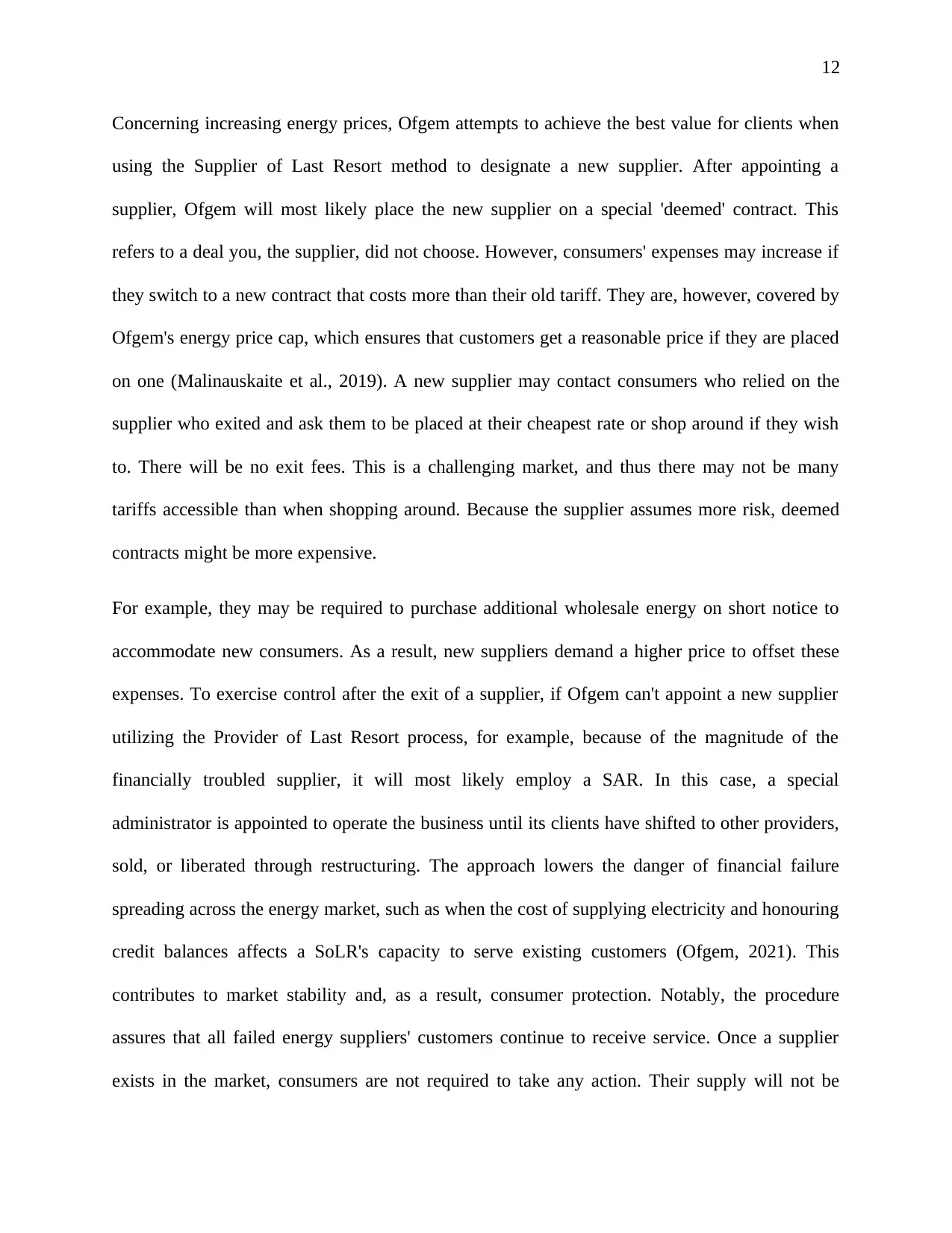
12
Concerning increasing energy prices, Ofgem attempts to achieve the best value for clients when
using the Supplier of Last Resort method to designate a new supplier. After appointing a
supplier, Ofgem will most likely place the new supplier on a special 'deemed' contract. This
refers to a deal you, the supplier, did not choose. However, consumers' expenses may increase if
they switch to a new contract that costs more than their old tariff. They are, however, covered by
Ofgem's energy price cap, which ensures that customers get a reasonable price if they are placed
on one (Malinauskaite et al., 2019). A new supplier may contact consumers who relied on the
supplier who exited and ask them to be placed at their cheapest rate or shop around if they wish
to. There will be no exit fees. This is a challenging market, and thus there may not be many
tariffs accessible than when shopping around. Because the supplier assumes more risk, deemed
contracts might be more expensive.
For example, they may be required to purchase additional wholesale energy on short notice to
accommodate new consumers. As a result, new suppliers demand a higher price to offset these
expenses. To exercise control after the exit of a supplier, if Ofgem can't appoint a new supplier
utilizing the Provider of Last Resort process, for example, because of the magnitude of the
financially troubled supplier, it will most likely employ a SAR. In this case, a special
administrator is appointed to operate the business until its clients have shifted to other providers,
sold, or liberated through restructuring. The approach lowers the danger of financial failure
spreading across the energy market, such as when the cost of supplying electricity and honouring
credit balances affects a SoLR's capacity to serve existing customers (Ofgem, 2021). This
contributes to market stability and, as a result, consumer protection. Notably, the procedure
assures that all failed energy suppliers' customers continue to receive service. Once a supplier
exists in the market, consumers are not required to take any action. Their supply will not be
Concerning increasing energy prices, Ofgem attempts to achieve the best value for clients when
using the Supplier of Last Resort method to designate a new supplier. After appointing a
supplier, Ofgem will most likely place the new supplier on a special 'deemed' contract. This
refers to a deal you, the supplier, did not choose. However, consumers' expenses may increase if
they switch to a new contract that costs more than their old tariff. They are, however, covered by
Ofgem's energy price cap, which ensures that customers get a reasonable price if they are placed
on one (Malinauskaite et al., 2019). A new supplier may contact consumers who relied on the
supplier who exited and ask them to be placed at their cheapest rate or shop around if they wish
to. There will be no exit fees. This is a challenging market, and thus there may not be many
tariffs accessible than when shopping around. Because the supplier assumes more risk, deemed
contracts might be more expensive.
For example, they may be required to purchase additional wholesale energy on short notice to
accommodate new consumers. As a result, new suppliers demand a higher price to offset these
expenses. To exercise control after the exit of a supplier, if Ofgem can't appoint a new supplier
utilizing the Provider of Last Resort process, for example, because of the magnitude of the
financially troubled supplier, it will most likely employ a SAR. In this case, a special
administrator is appointed to operate the business until its clients have shifted to other providers,
sold, or liberated through restructuring. The approach lowers the danger of financial failure
spreading across the energy market, such as when the cost of supplying electricity and honouring
credit balances affects a SoLR's capacity to serve existing customers (Ofgem, 2021). This
contributes to market stability and, as a result, consumer protection. Notably, the procedure
assures that all failed energy suppliers' customers continue to receive service. Once a supplier
exists in the market, consumers are not required to take any action. Their supply will not be
⊘ This is a preview!⊘
Do you want full access?
Subscribe today to unlock all pages.

Trusted by 1+ million students worldwide
1 out of 16
Related Documents
Your All-in-One AI-Powered Toolkit for Academic Success.
+13062052269
info@desklib.com
Available 24*7 on WhatsApp / Email
![[object Object]](/_next/static/media/star-bottom.7253800d.svg)
Unlock your academic potential
Copyright © 2020–2025 A2Z Services. All Rights Reserved. Developed and managed by ZUCOL.





